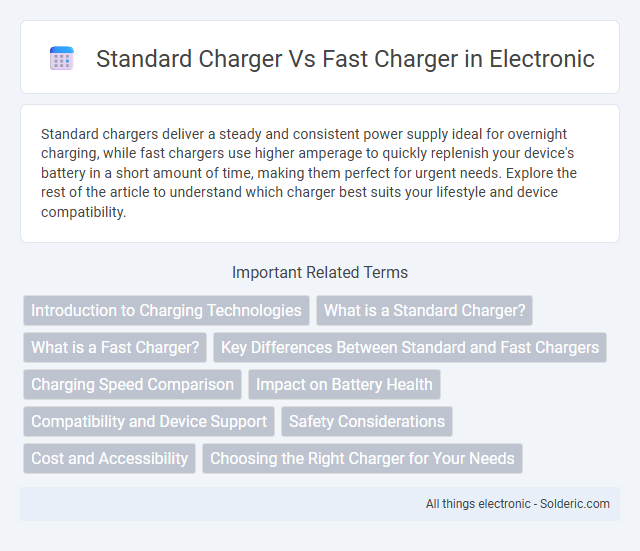Standard chargers deliver a steady and consistent power supply ideal for overnight charging, while fast chargers use higher amperage to quickly replenish your device's battery in a short amount of time, making them perfect for urgent needs. Explore the rest of the article to understand which charger best suits your lifestyle and device compatibility.
Comparison Table
| Feature | Standard Charger | Fast Charger |
|---|---|---|
| Charging Speed | Typically 5W to 10W | 20W to 100W or higher |
| Charging Time | 2 to 4 hours (phone) | 30 minutes to 1 hour (phone) |
| Compatibility | Universal USB charging | Requires compatible fast charge device and cable |
| Heat Generation | Low heat output | Increased heat, needs thermal management |
| Cost | Low cost, widely available | Higher cost, specialized technology |
| Battery Impact | Gentle on battery life | Potential long-term battery wear if overused |
Introduction to Charging Technologies
Standard chargers typically deliver power at rates around 5 to 10 watts, providing a reliable but slower charging experience ideal for overnight use or maintaining battery health. Fast chargers use advanced technology to increase power output to 18 watts or more, significantly reducing charging time by rapidly replenishing battery capacity. Understanding the differences in voltage, current, and compatibility helps you choose the most efficient charging method for your device's needs.
What is a Standard Charger?
A standard charger delivers a consistent power output, typically ranging from 5 to 10 watts, making it ideal for overnight charging and preserving battery health. It uses a regular USB port or wall adapter that supplies lower current, ensuring slower but safer energy transfer to devices such as smartphones, tablets, and wearable gadgets. Standard chargers are widely compatible across various brands and models, providing reliable and efficient energy replenishment without risking overheating or battery degradation.
What is a Fast Charger?
A Fast Charger delivers higher power output, typically ranging from 18W to 100W or more, enabling significantly faster battery replenishment compared to a Standard Charger, which usually outputs around 5W to 10W. Utilizing advanced technologies like USB Power Delivery (USB-PD) or Qualcomm Quick Charge, Fast Chargers optimize voltage and current to reduce charging time while ensuring device safety. Fast Charging is especially beneficial for smartphones, tablets, and laptops with compatible hardware, drastically improving daily usability and convenience by minimizing downtime.
Key Differences Between Standard and Fast Chargers
Standard chargers typically provide power output ranging from 5W to 12W, resulting in slower charging speeds suitable for overnight or extended use. Fast chargers deliver higher wattage, often between 18W and 65W or more, enabling significantly reduced charging times by rapidly increasing current and voltage to compatible devices. The key differences include charging speed, power output, heat generation, and compatibility with specific device standards such as USB Power Delivery (PD) and Qualcomm Quick Charge.
Charging Speed Comparison
Fast chargers deliver significantly higher power output, typically ranging from 18W to 65W or more, enabling smartphones to reach 50% charge in as little as 30 minutes. Standard chargers usually provide 5W to 10W power, resulting in a full charge time of 2 to 4 hours for most devices. The increased amperage and voltage in fast chargers enhance charging efficiency, reducing overall charging time compared to standard chargers.
Impact on Battery Health
Fast chargers deliver higher current to your device, which can generate more heat and potentially accelerate battery degradation over time compared to standard chargers. Standard chargers, with their lower power output, tend to maintain battery health more effectively by minimizing thermal stress and lithium-ion wear. Choosing the right charger impacts your battery's longevity and overall device performance.
Compatibility and Device Support
Standard chargers offer broad compatibility with a wide range of devices due to their lower power output, making them ideal for everyday use with smartphones, tablets, and accessories. Fast chargers, designed with higher wattage and advanced protocols like Qualcomm Quick Charge or USB Power Delivery, require your device to support these technologies to achieve optimal charging speeds. Ensuring your device's compatibility with a fast charger is crucial to prevent potential damage and to fully benefit from accelerated charging capabilities.
Safety Considerations
Standard chargers typically produce lower heat and operate within safer voltage limits, reducing the risk of battery overheating and damage. Fast chargers deliver higher voltage and current to accelerate charging, which requires advanced safety mechanisms like thermal management and overcharge protection to prevent potential hazards. Ensuring compatibility with device specifications and using certified chargers significantly enhances safety during both standard and fast charging processes.
Cost and Accessibility
Standard chargers typically cost less, ranging from $10 to $30, making them more accessible for general consumers and widely available in most retail stores. Fast chargers, priced between $30 and $70 or more, often require compatible devices and specialized technology, limiting accessibility for some users. The widespread use of USB-C ports has improved accessibility for fast charging, but the initial investment remains higher compared to standard chargers.
Choosing the Right Charger for Your Needs
Choosing the right charger depends on your device's compatibility and daily charging habits, as standard chargers provide steady power suitable for overnight charging, while fast chargers deliver higher wattage for quick top-ups. Your device's battery capacity and heat management system influence charging speed and safety, making it essential to select a charger that balances efficiency and longevity. Prioritizing a charger that matches your lifestyle helps maintain battery health and ensures optimal performance without risking overheating or damage.
Standard charger vs Fast charger Infographic

 solderic.com
solderic.com